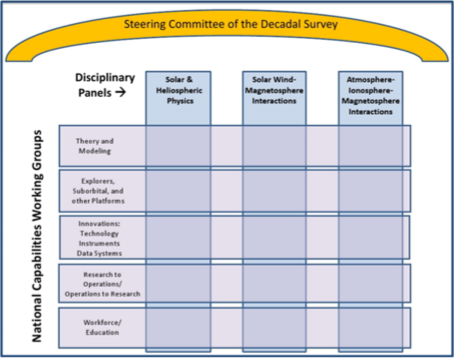HSD Support of the Decadal Strategy for Solar and Space Physics
HSD Support of the Decadal Strategy for Solar and Space Physics
The Space Studies Board of the National Research Council is conducting a broad-based assessment ("decadal survey'') of the scientific priorities of the U.S. solar and space physics research enterprise for the period 2013 - 2022. In conducting this assessment, there will be an emphasis on developing a systems approach to the theoretical, ground-based and space-based research programs that comprise the flight programs and focused campaigns of NASA, the ground-based and basic research programs of NSF, and the complementary operational programs of other agencies such as NOAA. This new decadal survey will update and extend the NRC's previous survey in solar and space physics, "The Sun to the Earth and Beyond:A Decadal Research Strategy in Solar and Space Physics" (2003). The survey committee, informed by three study panels that will also be established by the Board and supplemented by informal working groups, will broadly canvass the field of solar and space physics and:
- Provided an overview of the science and a broad survey of the current state of knowledge in the field, including a discussion of the relationship between space- and ground-based science research and its connection to other scientific areas
- Identified the most compelling science challenges that have arisen from recent advances and accomplishments
- Identified-having considered scientific value, urgency, cost category and risk, and technical readiness-the highest-priority scientific targets for the interval2013-2022, recommending science objectives and measurement requirements for each target rather than specific mission or project design/implementation concepts
- Developed an integrated research strategy that present means to address these targets.
-
HSD scientists held positions within the formal structure of the Survey, illustrated in the figure. M. Hesse (674) is a member of the Steering Committee as well as Co-Leader of the Working Group on Research to Operations/Operations to Research. S. Antiochos (674) is Vice Chair of the Panel on Solar and Heliospheric Physics. R. Pfaff (674) is a member of the Panel on Atmosphere- Ionosphere-Magnetosphere Interactions. L. Kepko (674) and R. Pfaff are members of the Working Group on Explorers, Suborbital, and Other Platform.

-
HSD scientists contributed as lead author or co-author to 24 of the White Papers, an integral part of the Survey process by which members of the heliophysics community can articulate their scientific priorities. HSD lead authors include:
- T. Moore (670), "Laboratory for Active Space Experiment Research (LASER)"
- T. Moore (670), "Mechanisms of Energetic Mass Ejection"
- 0. C. St. Cyr (670), "Space Weather Diamond: A lOx Improvement in Real-Time Forecasting"
- 0. C. St. Cyr (670), "Solar Orbiter: Exploring the Sun-Heliosphere Connection"
- K. Strong (670), "4PI: A Global Understanding of the Solar Cycle"
- S. Christe (671), "The Focusing Optics X-ray Solar Imager (FOXSI)"
- J. Davila (671), "Understanding Magnetic Storage, Reconnection, and CME Initiation"
- J. Davila (671), "The International Space Weather Initiative (ISWI)"
- N. Gopalswamy (671), "Earth Affecting Solar Causes Observatory (EASCO): A New View from SunEarth L5"
- J. Klimchuk (671), "Maximizing NASA's Science Productivity"
- A. Shih (671), "Solar Ion Acceleration and the Flaring Atmosphere"
- E. Christian (672), "Heliophysics Instrument and Technology Development Program (HITDP)"
- J. Cooper (672), "Space Weathering Impact on Solar System Surfaces and Mission Science"
- D. A. Roberts (672), "The Heliophysics Data Environment as an Enabler of HP Science of the Next Decade"
- A. Szabo (672), "Energetic Particle Propagation and Coronal Mass Ejection Evolution in the Inner Heliosphere: Multi-paint in-situ Solar Sentinels Observations"
- A. Szabo (672), "Solar Wind Kinetic Physics: High Time Resolution Solar Wind Measurements from the DSCOVR Mission"
- J. Dorelli (673), "Computational Heliophysics Innovation Program (CHIP)"
- S. Fung (673), "MAGnetosphere-Ionosphere Connector (MAGIC): Investigation of Magnetosphere- Ionosphere Coupling from High-to-Low Latitudes"
- L. Kepko (674), "Magnetospheric Constellation"
- L. Kepko (674), ''A NASA-funded CubeSat Program"
- R. Pfaff (674), "Understanding Geospace on a Grand Scale: The Global Ionosphere/ Thermosphere Constellation"
- R. Pfaff (674), "Sounding Rockets as Indispensable Research Platforms for Heliophysics Research and Development of a High Altitude Sounding Rocket"
- D. Rowland (674), "The Tropical Coupler Mission"
- S.E. Kanekal (672), ''Advancing our Understanding of magnetospheric, Solar Energetic Particle, and Cosmic Ray Physics: A proposed Mission to LEO"
HSD is also supporting the NASA Heliophysics Roadmap activity, of which L. Kepko (674) is co-chair. More broadly, HSD is partnering with the heliophysics community to advance key goals enunciated by the decadal strategy, including elements of the DRIVE initiative and the IMAP Solar-Terrestrial Probe.
